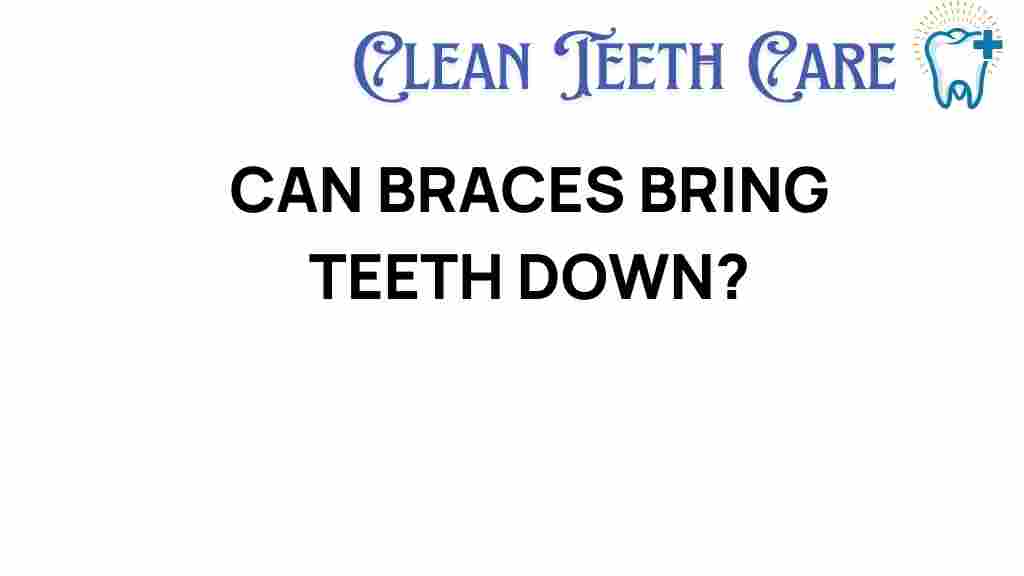The Surprising Truth: Can Braces Really Bring Teeth Down?
When it comes to dental health, many people are curious about the role of braces in achieving optimal teeth alignment. The idea that braces can actually bring teeth down is a common question that arises in the field of orthodontics. In this article, we’ll explore the surprising truth behind this concept, delve into how braces work, and guide you through the process of smile transformation. Whether you’re considering braces for yourself or simply looking to enhance your knowledge about dental treatment, this article is for you.
Understanding Braces and Their Function
Braces are orthodontic devices used to correct misaligned teeth and jaws. They play a crucial role in improving bite correction and overall dental health. Here’s how they work:
- Application of Pressure: Braces apply gentle pressure to teeth over time, which gradually shifts them into the desired position.
- Components: Braces typically consist of brackets, wires, and bands. The brackets are attached to the teeth, while the wires connect them, guiding the movement.
- Adjustment Visits: Regular visits to the orthodontist are necessary for adjustments, where the tension in the wires is modified to continue the movement of teeth.
Through these mechanisms, braces can effectively bring teeth down or pull them into alignment, depending on the specific needs of the patient.
The Process of Teeth Alignment with Braces
Getting braces is a multi-step process that involves careful planning and execution. Here’s a breakdown of what to expect:
- Initial Consultation: Schedule an appointment with an orthodontist to discuss your concerns and get a dental examination.
- Diagnostic Records: The orthodontist may take X-rays, photographs, and impressions of your teeth to create a customized treatment plan.
- Placement of Braces: Once the plan is established, the braces will be placed on your teeth. This process typically takes about an hour.
- Regular Adjustments: You will need to return to the orthodontist every 4-6 weeks for adjustments to ensure the braces continue to work effectively.
- Retention: After the braces are removed, retainers may be necessary to maintain the new alignment of your teeth.
Throughout this process, you can expect noticeable changes in your smile, which is the ultimate goal of orthodontics.
Can Braces Really Bring Teeth Down?
The short answer is yes; braces can bring teeth down. However, the extent to which this occurs depends on several factors, including:
- Initial Position of Teeth: If teeth are significantly elevated or misaligned, braces can effectively pull them down into proper alignment.
- Type of Braces: Different types of braces (metal, ceramic, lingual, or clear aligners) may have varying effectiveness in achieving desired outcomes.
- Duration of Treatment: The length of time you wear braces will also influence how much your teeth can be moved.
- Patient Compliance: Following the orthodontist’s instructions and attending regular appointments are crucial for successful treatment.
In essence, braces are designed to move teeth into their optimal positions, which can include bringing them down if necessary.
Benefits of Braces for Dental Health
Braces offer numerous benefits beyond just cosmetic improvements. Here are some key advantages:
- Improved Bite Correction: Proper alignment helps in achieving a better bite, which can alleviate issues like overbites or underbites.
- Enhanced Oral Care: Straight teeth are easier to clean, reducing the risk of cavities and gum disease.
- Boosted Self-Esteem: A well-aligned smile can enhance your confidence and social interactions.
- Long-term Dental Health: Correcting alignment issues can prevent future dental problems, ensuring better overall oral care.
Troubleshooting Common Concerns
While braces are effective, patients often face challenges during their treatment. Here are some common issues and how to address them:
- Discomfort: It’s normal to experience soreness after getting braces or adjustments. Over-the-counter pain relief can help.
- Loose Brackets: If a bracket comes loose, contact your orthodontist for guidance on how to handle it.
- Dietary Restrictions: Avoid hard, sticky foods that can damage your braces. Focus on soft foods during the adjustment period.
- Oral Hygiene Challenges: Maintain excellent oral care by brushing and flossing regularly, using tools designed for braces.
By staying informed and proactive, you can navigate these common hurdles effectively.
Maintaining Dental Health During Orthodontic Treatment
Taking care of your dental health while wearing braces is crucial for achieving the best results. Here are some tips to keep your teeth healthy:
- Brush After Every Meal: This helps remove food particles that can get trapped in braces.
- Use a Soft-Bristled Toothbrush: A soft brush will prevent damage to your braces and gums.
- Floss Daily: Use floss threaders or orthodontic floss to clean between teeth effectively.
- Regular Dental Visits: Continue to see your general dentist for check-ups and cleanings during your orthodontic treatment.
Maintaining good oral hygiene will support the success of your orthodontic treatment and enhance your smile transformation.
Conclusion
In conclusion, braces are a powerful orthodontic tool that can indeed bring teeth down and achieve the desired alignment for a healthier smile. Understanding how braces work and their impact on dental health is essential for anyone considering this dental treatment. With the right approach, patients can experience a significant transformation in their smile and overall oral care. If you’re ready to take the first step toward a beautiful smile, contact an orthodontist today.
For more information on braces and orthodontics, check out this helpful resource. Remember, a confident smile is just a treatment away!
For personalized advice, consider consulting your local dental professional about your orthodontic needs.
This article is in the category Treatments and created by CleanTeethCare Team
